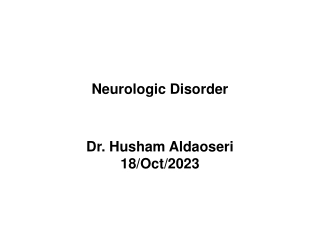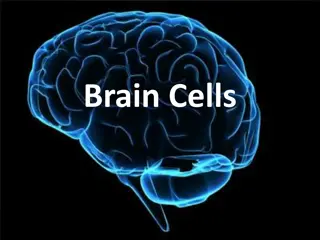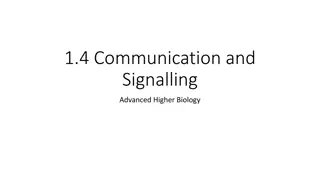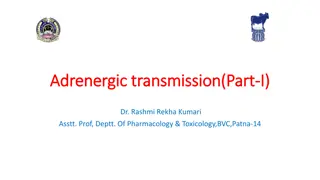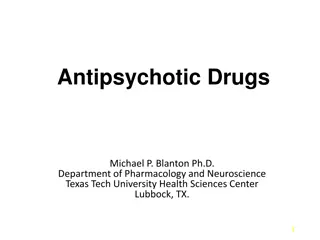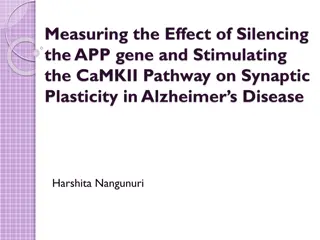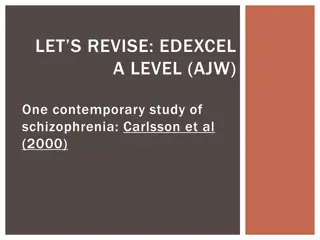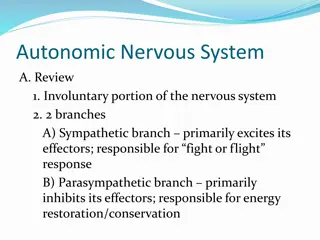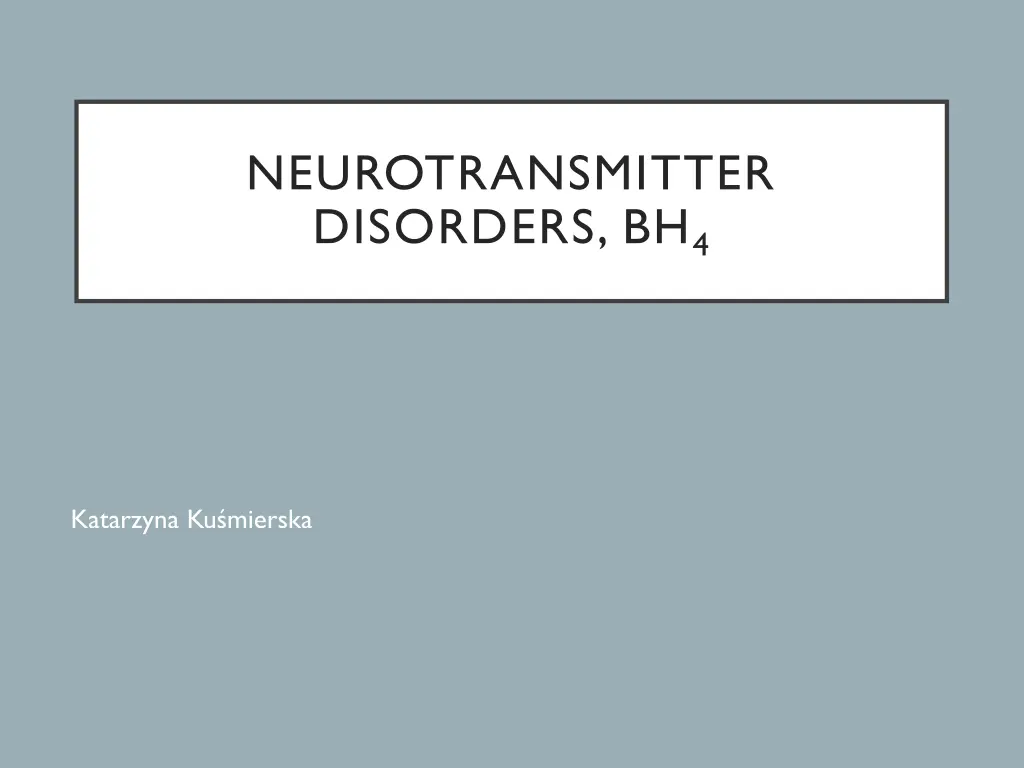
Pediatric Neurotransmitter Diseases Overview
Pediatric neurotransmitter diseases encompass genetic disorders affecting neurotransmitter metabolism, including issues with synthesis and breakdown. Conditions such as epilepsy can be linked to inborn errors of metabolism, impacting brain function and control of seizures. Specific genetic disorders like urea cycle disorders and metabolic encephalopathies can manifest with epileptic encephalopathy, highlighting the importance of early diagnosis and targeted interventions.
Download Presentation

Please find below an Image/Link to download the presentation.
The content on the website is provided AS IS for your information and personal use only. It may not be sold, licensed, or shared on other websites without obtaining consent from the author. If you encounter any issues during the download, it is possible that the publisher has removed the file from their server.
You are allowed to download the files provided on this website for personal or commercial use, subject to the condition that they are used lawfully. All files are the property of their respective owners.
The content on the website is provided AS IS for your information and personal use only. It may not be sold, licensed, or shared on other websites without obtaining consent from the author.
E N D
Presentation Transcript
NEUROTRANSMITTER DISORDERS, BH4 Katarzyna Ku mierska
PEDIATRIC NEUROTRANSMITTER DISEASES IS AN UMBRELLA TERM FOR GENETIC DISORDERS THAT AFFECT THE METABOLISM OF NEUROTRANSMITTERS (SYNTHESIS AND BREAKDOWN)
EPILEPSY IN IEM Only a small percentage (< 2%?) of individuals with epilepsy have an IEM. In 20% of cases, seizures are untreatable or very difficult control because of: Diffuse or localized structural brain abnormality Epileptic encephalopathy (Lennox Gastaut, etc.) IEM Seizures are a very common symptom in IEM: Major manifestation or One among many other problems. Not always refractory to AED
NEONATAL METABOLIC EPILEPTIC ENCEPHALOPATHY Urea Cycle Disorders Methylmalonic, Propionic Acidurias, etc. Marple Syrup Urine Disease Non ketotic Hyperglycinemia Pyridoxine dependant Epilepsy Biotinidase Deficiency Perinatal Hypophosphatasia Adenylsuccinate Lyase Deficiency MTHFR Deficiency D /D ,L 2 Hydroxyglutaric Aciduria Congenital Disorders of Glycosylation 3 Phosphoglycerate Dehydrogenase Deficiency GABA T Deficiency Congenital Glutamine Deficiency Glutamate Transporter Deficiency (Creatine Deficiency Disorders) Blue indicates disorders, for which specific treatments exists. G.F. Hoffmann: Inherited metabolic disorders presenting as epileptic encephalopathy
INFANTILE METABOLIC ENCEPHALOPATHY GLUT1 Deficiency Urea Cycle Disorders Methylmalonic, Propionic Acidurias, etc. Marple Syrup Urine Disease Non ketotic Hyperglycinemia Pyridoxine dependant Epilepsy Biotinidase Deficiency Menke disease (Canavan disease) Sulphite Oxidase/ Molybdenum Cofactor Deficiency Generalized Peroxisomal Disorders Mitochondriopathies (especially MERRF) Congenital Disorders of Glycosylation Smith Lemli Opitz syndrome Adenylsuccinate Lyase Deficiency D /D ,L 2 Hydroxyglutaric Aciduria Folate Receptor Defect MTHFR Deficiency Creatine Deficiency Disorders CAD (multifunctional enzyme complex, first steps of de novo pyrimidine biosynthesis) Neuronal Ceroid Lipofuscinoses (NCL)
JUVENILE & ADULT ONSET Acute intermittent porphyria Adrenoleukodystrophy, X linked GM1 gangliosidosis Mitochondriopathies Neuronal ceroid lipofuscinoses Niemann Pick type C disease Sialidosis I
WHICH DIAGNOSTIC TESTS? TODAY Amino acids in plasma/urine Organic acids in urine Acylcarnitines in plasma Aminoacids in plasma/CSF Orotic acid in urine Amino acids in plasma Neurotransmitters
INDICATIONS FOR NEXT GENERATION SEQUENCING Panel diagnostics (out of massive parallel sequencing) Mitochondrial diseases Mental Retardation Epilepsy Dystonia Ataxia Ophtalmological disorders Liver failure In parallel: Comprehensive metabolic investigations
NEUROTRANSMITTER DISORDERS METABOLISM AND/OR TRANSPORT OF BIOGENIC AMINES GLUTAMATE -AMINOBUTYRIC ACID (GABA) GLYCINE http://lyrobossite.free.fr/Structure_II_L'axone.htm
THE CLINICAL DIAGNOSIS OF INHERITED NEUROTRANSMITTERS DISORDERS IS VERY DIFFICULT AND NEEDS SPECIALIZED DIAGNOSTIC PROCEDURES FOR DETECTION Analysis of neurotransmitter disorders requires LUMBAR PUNCTURE
Because there is a rostrocaudal concentration gradient of biogenic amine metabolites in cerebrospinal fluid the standard protocol is critical Fraction I BIOGENIC AMINE METABOLITES / 5-MTHF (0,5 ml of CSF) Fraction II AMINO ACIDS (1 ml of CSF) Fraction III ROUTIN BIOCHEMICAL ANALYSIS (1-2 ml of CSF) Fraction IV - GABA (1 ml of CSF) Fraction V - PTERIN (1 ml of CSF)
MONOAMINES Biogenic amines CATECHOLAMINES: DOPAMINE + NOREPINEPHRINE SEROTONIN
GTP Neopteryn PAH TRYPTOPHAN (TP) TYROSINE (T) Phenylalanine BH4 TPH TH BH2 3-OMD L-Dopa 5-OH-TRYPTOPHAN AAD CB6 DBH Norepinephri ne DOPAMINE SEROTONINE MAO MAO HVA 5-HIAA
INHERITED DISORDERS AFFECTING MONOAMINES METABOLISM or TETRAHYDROBIOPTERIN DEFICIENCY and INHERITED DISORDERS AFFECTING MECHANISMS CONTROLLING NEUROTRANSMISSION cause syndromes of MONOAMINE NEUROTRANSMITTER DEFICIENCY with ABNORMAL PATTERN OF MONOAMINE METABOLITES IN CEREBROSPINAL FLUID
REFERENCE VALUES 0- 6 m 6 12m 1 4 yrs > 4 yrs HVA [nmol/L] 300 - 1000 300 - 1000 200 - 800 100 - 600 5-HIAA [NMOL/L] 300 - 1000 200 - 800 100 - 600 < 50 3-OMD [NMOL/l] 100 - 300 < 100 <50 <50
SYNTHESIS OF THE NEUROTRANSMITTERS CAN BE SEVERELY COMPROMISED WHEN THERE ARE DEFECTS AFFECTING THE ENZYMES INVOLVED BH4 GTP Neopteryn TRYPTOPHA N (TP) TYROSINE (T) BH4 T H TPH BH2 L-Dopa 5-OH-TRYPTOPHAN
TETRAHYDROBIOPTERIN (BH4) IS THE COFACTOR FOR phenylalanine hydroxylase (EC 1.14.16.1), phenylalanine tyrosine tyrosine hydroxylase (EC 1.14.16.2), L-Dopa tyrosine tryptophan hydroxylase (EC 1.14.16.4), tryptophan 5-hydroxytryptophan citruline + NO. nitric oxide synthase arginine glyceryl-ether monooxygenase 1-O-alkyl-glycerol alkyl-adehyde + glycerol QUINONOID DIHIDROBIOPTERIN (Q-BH2)
TETRAHYDROBIOPTERIN IS ALSO COFACTOR FOR THE PHENYLALANINE HYDROXYLASE IN THE LIVER DEFECTS OF TETRAHYDROBIOPTERIN METABOLISM ARE IDENTIFIED BECAUSE OF THE PRESENCE OF HYPERPHENYLALANINEMIA FOLLOWING NEWBORN SCREENING THESE DEFECTS MAY PRESENT PHENOTYPICALLY WITH OR WITHOUT HYPERPHENYLALANINEMIA
CLINICAL SYMPTOMS ARGTPCH, PTPS, AND DHPR DEFICIENCIES Neonatal period (hyperphenylalaninemia) poor sucking, decreased spontaneous movements, floppy baby
ARGTPCH, PTPS, AND DHPR DEFICIENCIES Infancy and childhood disturbance of tone and posture abnormal movements hypersalivation and swallowing difficulties mental retardation convulsions (grand mal or myoclonic attacks), drowsiness, irritability recurrent hyperthermia without infections diurnal fluctuation
ADGTPCH, SR without hyperphenylalaninemia dystonia (lower limbs, trunk, arms, neck) parkinsonism (associated with tremor, rigidity, bradykinesia) oculogyric crises (only SR) psychomotor retardation (only SR)
MRI of the brain normal mild cerebral atrophy EEG normal epileptiform potentials
IN SOME NEUROLOGICAL DISORDERS SECONDARY ABNORMALITIES OF MONOAMINES METABOLITES PATTERN ARE OBSERVED (HVA and 5-HIAA) the group of patients with low biogenic amine metabolites values in CSF Lesch Nyhan disease Alexander disease mitochondrial encephalopathies pontocerebellar hypoplasia other encephalopathies Patients with basal ganglia involvement did not manifest lower values of neurotransmitters Garc a-Cazorla A. and all.; Developmental Medicine & Child Neurology 2007, 49: 740 744
TH is responsible for the synthesis of l- dopa, a precursor of catecholamines, which can be methylated to 3-OMD and its final product - vanillyllactic acid (VLA) or decarboxylated to dopamine; Dopamine is stored in presynaptic vesicles and then released into the synaptic cleft; The complex process is regulated by transporters that play a key role in dopaminergic neurotransmission The biochemical diagnosis of THD is based only on the analysis of AB metabolites in CSF and genetic tests
CEREBRAL FOLATE DEFICIENCY The presence of folate deficiency in the central nervous system in the presence of normal peripheral folate constitutes the syndrome of cerebral folate deficiency (CFD). CFD can be secondary to: - drug-induced folate deficiency, - DHPR deficiency, - 3-phosphoglycerate dehydrogenase deficiency, - AADC deficiency. Folate is an essential cofactor in DNA synthesis and methylation reactions and is a critical determinant of embryonic CNS development. In its various forms, folic acid participates in the synthesis of: - purines and pyrimidines, - the metabolism of serine, histidine, methionine, homocysteine and glycine.
CEREBRAL FOLATE DEFICIENCY (CFD) IS DEFINED AS ANY NEUROLOGICAL SYNDROME ASSOCIATED WITH A LOW CEREBROSPINAL FLUID (CSF) CONCENTRATION OF 5-METHYLTETRAHYDROFOLATE (5MTHF) IN THE PRESENCE OF NORMAL PERIPHERAL FOLATE STATUS Reference values for 5-MTHF in CSF 1 4 yrs 72 - 227 > 4 yrs 40 - 180 5-MTHF [nmol/L] Hyland K. et all 2010
CEREBRAL FOLATE DEFICIENCY deceleration of head growth from the age of 4 to 6 mo irritability, and sleep disturbances delayed acquisition of neurodevelopmental milestones poor postural control cerebellar ataxia dyskinesias paraparesis with pyramidal deficits autistic features epilepsia (myoclonic-astatic seizures, absences and generalized tonic- clonic seizures) Hyland K. et all 2010
GLYCINE ENCEPHALOPATHY - Glycine, the simplest amino acid with a single amino and carboxyl group, may accumulate to pathological levels in a disorder of the glycine cleavage system, leading to nonketotic hyperglycinemia (NKT), or glycine encephalopathy. PLP Serine Serine + Tetrahydrofolate Glycine + metyltetrahydrofolate hydroxymethyltransferase - Defects of the glycine cleavage system are detected by a ratio of CSF to plasma glycine: N:> 0.08.
GLYCINE Structural amino acid Metabolic intermediate Conjugates for detoxification Neurotransmitter (inhibitory in spinal cord) Adjuvant to NMDA receptor
NONKETOTIC HYPERGLYCINEMIA NEONATAL SEVERE lethargy progressing to coma hypotonia seizures hypoventilation, and apnea EEG - burst-suppression pattern severe mental retardation severe myoclonic and generalized seizure disorder spastic quadriplegia
NONKETOTIC HYPERGLYCINEMIA VARIANT LATE-ONSET late onset in infancy or childhood seizures moderate mental retardation ataxia hyperactivity and/or chorea
CLINICAL SYMPTOMS developmental delay prominent language deficits hypotonia ataxia seizures MRI - increased signal in the globus pallidus
NON-KETOTIC HYPERGLYCINAEMIA Treatment Sodium benzoate lowers plasma glycine Dextromethorphan / ketamine Anticonvulsants
Confirmatory tests Enzyme assay Liver Transformed lymphoblasts Mutation analysis Prenatal diagnosis Enzyme assay on CVB (uncultured) Sometimes equivocal Mutation analysis
SECONDARY HYPERGLYCINAEMIA Sodium valproate Organic acidaemias Pyridoxine / Pyridoxal-P dependency
PYRIDOXINE RESPONSIVE EPILEPSY Onset usually neonatal, maybe up to 2 yrs Multiple seizure types Usually resistant to anticonvulsants Seizures Often fetal distress, acidosis, hypotonia Usually dramatic response to IV pyridoxine Apnoea / hypotension for 24 hours
PYRIDOXINE RESPONSIVE EPILEPSY Treatment Pyridoxine 5-10 mg/kg/day (peripheral neuropathy with high doses)
Glutamate decarboxylase GABA transaminase Aromatic aminoacid decarboxylase Glycine cleavage enzyme Lysine Pipecolic acid -aminoadipic semialdehyde piperideine 6-carboxylate Pyridoxal phosphate AASA dehydrogenase Inactive product
Metabolism of Glutamate and GABA GABA transaminase Glutamate decarboxylase phosphate activated glutaminase Glutamine Glutamate GABA PNP PNP SSAD dehydrogenase Succinate Succinate semialdehyde (SSAD) NADH The functional status of the central nervous system (CNS) is based on a highly regulated balance between excitatory and inhibitory circuits. Based on the fact that these neurotransmission systems to a large extent are using the two amino acids Glutamate and GABA as transmitters in excitation and inhibition, respectively.
GABA GABA transaminase deficiency 2 families reported Seizures Severe developmental delay Diagnosis by CSF GABA GABA transaminase Succinate semialdehyde SSA dehydrogenase Succinate
GABA GABA transaminase Succinate semialdehyde 4-hydroxybutyrate SSA dehydrogenase Succinate
SSADH DEFICIENCY Developmental impairment esp. speech Behaviour problems Ataxia Seizures Diagnosis: 4-hydroxybutyrate on urine OA Treatment: supportive (vigabatrin ineffective)
NEUROTRANSMITTER DISORDERS: SUMMARY Present with seizures, developmental impairment, extrapyramidal or eye movement disorders, startle, hypotonia, sleep or behaviour problems etc Mostly in neonates or infants but sometimes later Awareness is essential Specific treatment is needed for some disorders Consider therapeutic trial (B6, Dopa) Some disorders detected by OAs, AAs Specialist analysis of CSF is required for others Protocol for CSF collection is important

